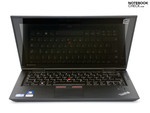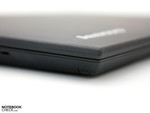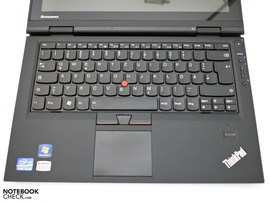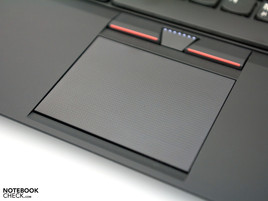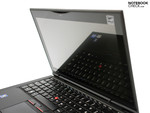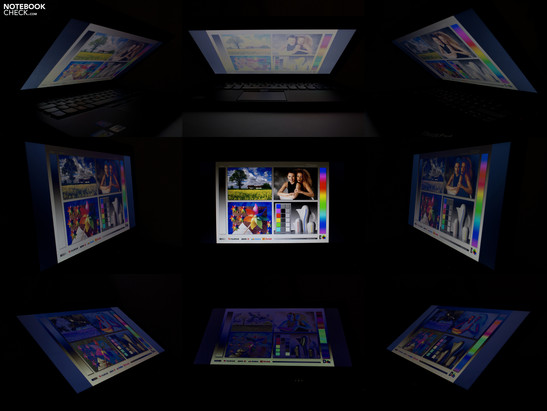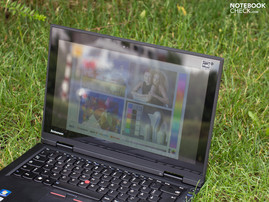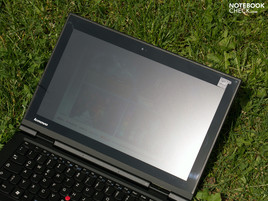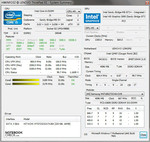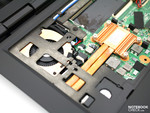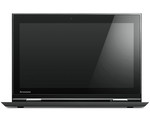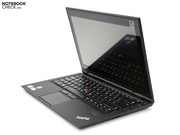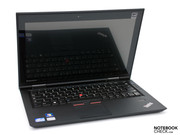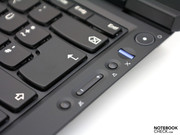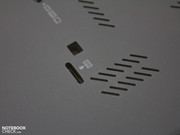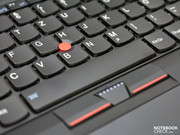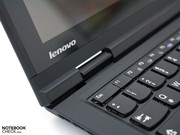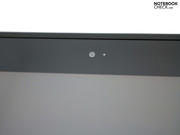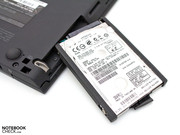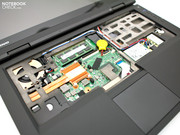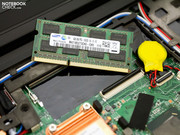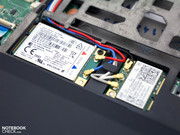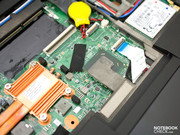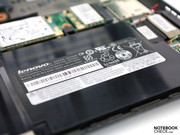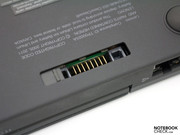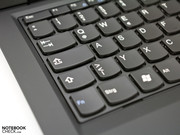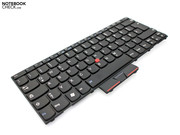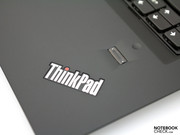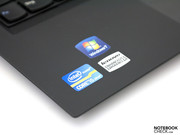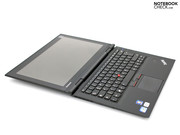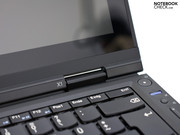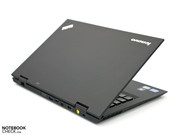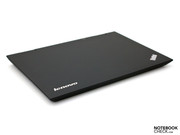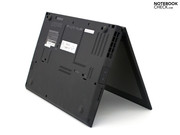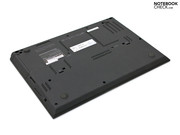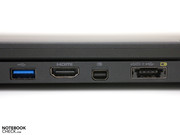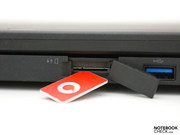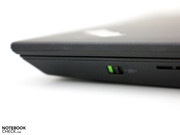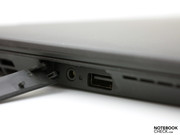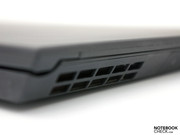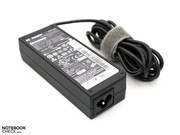Review Lenovo ThinkPad X1 Subnotebook

With the ThinkPad X1, Lenovo presents its thinnest business notebook yet and aims to combine performance and mobility in a sleek, elegant case. The subnotebook has a 13.3" screen (1366 x 768 pixels) and weighs a total of 1.75 Kg. In covering the screen with sturdy pane of Gorilla Glass similar to the ThinkPad Edge E-Series (Review Lenovo ThinkPad Edge E420s), Lenovo brings a novelty to the business notebook world. The X1 is, therefore, a bit of a renegade when it comes to business laptops which usually sport a matte finish on the screen.
Inside the sleek case we find the most recent of hardware. The subnotebook is equipped with an Intel Core i5-2520M dual-core CPU (2.5–3.2 GHz, 35 watts TDP, vPro) and on-board graphics card. The ports found here include USB 3.0, Mini-DisplayPort, HDMI and a UMTS module. Various hard drives are available (HDD or SSD) as well as your choice of 4 or 8 GB RAM (1 slot).
The configuration of Lenovo ThinkPad X1 we reviewed goes by the model number NWK2PGE—that is, the entry-level model. The laptop will run you 1599 Euro (RRP), a bit pricey for a subnotebook.
Case
The signature trait of the ThinkPad X1 is without question its very thin case. The width and depth of 337 x 231 cm are typical for 13.3" a subnotebook, but the maximum height of 2.13 cm more closely resembles the thinness of larger ThinkPads. Compared to similar notebooks marketed for personal rather than professional use, the MacBook Air 13 Late 2010 (17mm) and Samsung 900X3A (16,3mm) are even thinner, however. In terms of craftsmanship and feel, the X1 can compete with the best of them, although the ThinkPad T420 is of higher overall quality. The matte black surfaces with a soft-touch finish are very resistant to scratches and fingerprint marks. The case, however, seems to almost magically attract tons of dust.
One of the factors contributing to the sturdy base unit is the magnesium-aluminum alloy the case consists of—which most notebooks made from plastic just can't measure up to. The palm rest and entirety of the keyboard barely caves in when we push it in hard—although this level of stress is not typical of everyday use. The display lid is pretty firm but still twists a bit when pressure is applied despite the Gorilla Glass. An upside of the of the display lid design—which might be considered a downside by some—is that it consists of two halves which respond to pressure applied and prevent the screen from tearing or the Gorilla Glass from snapping. The display lid hinges match the case design and hold the display lid tight. The screen stays firmly in place and opens up to a full 180º.
Like other ThinkPads, the base plate of the X1 offers no hatch to access hardware. An interesting pattern of stickers and air intakes adorns the base plate surface. The hard drive can be accessed via the right edge of the keyboard and most of the rest of the hardware can be tinkered with after lifting up the keyboard. The battery is not removable and is located beneath the palm rest.
Connectivity
The wedge-shaped case doesn't leave much room for ports, most of which Lenovo places along the rear edge, making for messy, intertwined cables. Next to the RJ-45 Ethernet port, we have the power connector and Kensington Lock slot as well as several of the newest ports: USB 3.0, HDMI 1.4a, a eSATA/USB 2.0 combination port and a Mini-DisplayPort—which allows you to hook up an additional display without any the use of any extra hub and gives a high-resolution picture on a maximum of 2 screens at once. As far as transferring data goes, the USB 3.0 and eSATA should have you more than covered.
Along the left edge there's a small flap hiding another USB 2.0 port and a combination audio port (headphone jack / mic output). Similar to the card reader on the other side, when using these ports, the case has to be raised up since these ports are located very close to the bottom of the case. The wireless switch on the right side allows you to quickly turn the wireless connection on or off, for which most laptops simply have a Fn-shortcut. All in all, the ThinkPad X1 offers a wide array of fairly well-positioned ports despite it's compact case. The X1 unfortunately lacks a dockingport, which really should belong on any business notebook.
Internet and Bluetooth
Many ways to connect to the intertnet are offered with the X1. In addition to the gigabit Ethernet port, there's 802.11b/g/n wifi and Bluetooth 3.0 +HS. This translates to state of the art internet connections on top of which we have the potential to connect on the go via the 3G-UMTS module from Ericsson. Like with many Lenovo notebooks, we're dealing with a PCI Express Mini Card here which can potentially be swapped out and replaced with a small solid state drive (SSD). An option would be Intel's SSD Series 310: 40 or 80 GB.
Security
In the business world, data security is priority number one. The fingerprint scanner just below the keyboard is one layer of security. Along the back edge next to the Kensington Lock Slot we also find a TPM Security Chip. What's lacking is only a SmartCard reader and the encryption tool BitLocker, which is only available in Microsoft Windows 7 Ultimate.
Accessories
In the large box the notebook's delivered in we find the usual accessories: 90-watt power supply (cable lenght: 180 + 90 cm) and various documentation. Lenovo does not include any recovery discs or such. Additional accessories are available from Lenovo, but it's worth shopping around since these might be cheaper elsewhere. The software pre-installed on the laptop is typical of consumer laptops—nothing special—although Microsoft Office 2010 Starter and Adobe Reader X are quite useful.
Warranty
With the 36-month on-site service warranty, there's little left to be desired. Other manufacturers of business notebooks usually include only a 12-month warranty and extensions cost extra. Lenovo too offers extensions at an additional cost, but three years is usually enough and offers beyond that are likely of interest only to large businesses.
Input Devices
Keyboard
The top of the X1's base unit is definitely modeled off the new E-series. Except for the very fine details, the keyboard here is the same as the one found in the already-reviewed Lenovo ThinkPad E420s. The chiclet layout contains clearly marked keys and a sturdy key bed. Compared to the tiny lights of other ThinkPads, the LED backlight for the keyboard is quite convenient and can be adjusted to three levels of brightness using a Fn-key shortcut (bright, dim, off). In case you clumsily spill a drink on the keyboard, there are two openings in the base plate through which the liquid should drip out, protecting the hardware from damage.
The special function keys like the volume buttons and the blue ThinkVantage key are located to the right of the keyboard. This position seems ideal for quick access. The feel of typing on the keyboard is nice, the keys are moderately raised and the keystrokes show an easy-to-feel pressure point. The quiet concave keys make it easy and pleasant to type for hours on end.
Touchpad
The touchpad is new and illustriously named the keyless UltraNav TouchPad. The rectangular design (75 x 58 mm) is similar to that of the Lenovo ThinkPad T420, and just about the entire surface acts as one big left-click key as it presses in slightly. The right-click function can be activated by clicking the very lower right of the touchpad. The slightly textured surface allows for comfortable navigation of the cursor. The touchpad is slightly recessed, making it easy to feel it out without looking and the click-function shows good feedback. The upper half of the touchpad surface, however, requires a good deal more pressure to click than the lower half. The dimensions of the touchpad could stand to be a bit more generous.
An alternative to using the touch pad is the red trackpoint including additional mouse buttons found just above the touchpad. The trackpoint is comfortable to use and leaves no room for complaints.
Hope it's like the ThinkPad Edge's display? Too bad! Lenovo chose to set a glass pane in front of the screen of the ThinkPad X1, which really should have retained the matte finish of other ThinkPads. As opposed to the ThinkPad Edge E420, the screen here is covered in a pane of sturdy Gorilla Glass from manufacturer Corning, but its glossy, glossy finish might be a deal breaker for many potential customers. The screen measures 33 cm diagonally, that is, 13.3" and has a native resolution of 1366 x 768 pixels at an aspect ratio of 16:9, making it a very typical consumer laptop screen. We would have liked to see 1440 or 1600 horizontal pixels which would make screen contents a good deal clearer and easier to work with. Still, hooking up the laptop to an external monitor via the HDMI output at 1920 x 1080 pixels (Full HD) or even to two monitors via the Mini-DisplayPort at 2560 x 1440 pixels leaves little to be desired!
Lenovo's claim about the screen brightness in the X1 reaching a very high 350 nits is definitely cause for excitement. However, upon testing we could only measure a maximum of 320 cd/m²—still very good. The laptop with the brightest screen in our entire database is currently the Samsung 900X3A with a ridiculously bright 400 cd/m² display. It's not just the center of the screen that's very bright in the X1, its brightness distribution of 90% means the entire screen is very evenly lit and differences in luminance among parts of the screen cannot be discerned with the naked eye.
| |||||||||||||||||||||||||
Brightness Distribution: 90 %
Center on Battery: 319 cd/m²
Contrast: 118:1 (Black: 2.71 cd/m²)37.9% AdobeRGB 1998 (Argyll 2.2.0 3D)
54.3% sRGB (Argyll 2.2.0 3D)
36.54% Display P3 (Argyll 2.2.0 3D)
The results of later tests, however, show a bit of a downward spiral, placing the screen overall among average consumer panels. The black level of 2.71 cd/m² is far too high and blacks appear to have an unmistakable gray tone. The poor contrast ratio (118:1) is also a result of the high black level. To the naked eye, the range of colors and picture sharpness is satisfying, but does the displayable color space suffice for professional use (image processing)? The sRGB color space—an important standard for many programs—is not covered by the X1 and it doesn't measure up too well to other professional notebooks either. But for personal use without big photo-editing ambitions, the color space here is more than enough.
The ThinkPad X1 is hardly suited for outdoor use because of its reflective screen. In shady spots, the high screen brightness (which can be adjusted to 15 increments) is enough to keep irritating reflections at bay. In direct sunlight, however, the picture on the screen is impossible to make out even at maximum brightness. Business notebooks with a matte screen are clearly the way to go in this scenario. A matte screen protector might be of aid here, but like with MacBook Pro models, the glass pane already in place might make installing the additional screen protector impossible.
The range of viewing angles on the display model number LP133WH2-TLM5 are those of a typical TN panel just like the black level and screen contrast. Looking at the screen from the left or the right results in no distortions of the picture even at sharper viewing angles. It's a different story when tilting the screen back and forth. A small tilt away from the ideal viewing angle is enough for the picture to either start looking like a negative of itself or very overexposed.
Performance
Inside the case we find current hardware from Intel specially designed for professional applications. There are no options when it comes to the CPU, which is an Intel Core i5-2520M dual-core processor—a good choice among upper mid-grade CPUs. With a base clock rate of 2.5 GHz and 3 MB L3-cache, this processor is about as fast as the older Intel Core i5-580M or Core i7-740QM, although some of the technology here has clearly taken a few strides forward. For one, there's Hyper Threading (2 cores, 4 threads) as well as the Turbo Boost overclocking function and Energy Saver. Depending on the demands of the application at hand, the CPU clock rate fluctuates between 800 MHz and a max. of 3.2 GHz. It's interesting that the Energy Saver does not kick in when the system's set to the "high performance profile". As soon as we changed the performance profile, the clock rate was automatically adjusted, so we can exclude the possibility of a problem with the CPU's SpeedStep.
A nice bundle of features that's included is known as vPro. In addition to the functions of a regular consumer notebook, vPro provides additional processor technologies, hardware improvements as well as administration and security features. vPro also allows you to remotely observe and control the laptop to troubleshoot problems. All in all, it's a neat set of features that'll probably only find use within corporations, however. You can find out more about these features on Intel's Website.
There's no dedicated graphics card in the X1. Rather, the on-CPU integrated Intel GMA HD 3000 takes care of rendering images and videos. With DirectX 10.1 and Shader 4.1 support, the integrated GPU is not exactly cutting edge but is enough for performing most office and multimedia tasks rather quickly.
To start our obstacle course of tests we have the CPU benchmarks from Maxon. The Intel Core i5-2520M earns a good 10627 points in the multi-thread rendering test in CineBench R10 (64-bit). Among notebooks that received similar scores are the Lenovo ThinkPad X220 (currently being reviewed) and the Dell Vostro 3350 Subnotebook. The dual-core CPU here running at 2.5 GHz ranks in between the popular Intel Core i5-2410M and the premium dual-core Intel Core i7-2620M. The difference amounts to +7.4% (9839 points, Dell XPS 15) and -5.6% (11279 points, Schenker XMG A501) respectively.
The CPU benchmark in the more current CineBench R11.5 (64-bit) gives our processor 2.9 points; the ThinkPad X1 therefore actually catches up to the more powerful Schenker notebook, placing the processor once again among upper mid-grade CPUs. The smaller i5-2410M earns 2.6 points, putting it around 10.3% behind. Overall an impressive performance placing the processor just about on par with the premium dual-core i7-2620M. A configuration with the Intel Core i3-2310M would also have been a decent choice, considering it would suffice for most office and multimedia applications (no Turbo Boost). However, the i3-2510M trails a whole 2 points (Acer Aspire 3750)—that is—31% behind our Intel Core i5-2520M.
| 3DMark 03 Standard | 7771 points | |
| 3DMark 05 Standard | 5898 points | |
| 3DMark 06 Standard Score | 3311 points | |
| 3DMark Vantage P Result | 1688 points | |
Help | ||
Although 3D performance might not be the strong suit of the integrated Intel GMA HD 3000 graphics card, a review of the GPU wouldn't be complete without the synthetic gaming benchmarks from Futuremark. In 3DMark 06, the ThinkPad X1 earns a decent 3311 points, ranking in slightly below average in our database. The AMD Mobility Radeon HD 3650 entry-level GPU tends to perform just about the same in laptops with similar configurations. On the other hand, the lower mid-grade Nividia GeForce GT 520M dedicated GPU with DirectX 11 support performs a good deal more quickly in the Asus U30SD, receiving 4754 points (difference: 30.4%). Nevertheless, for most office applications the integrated GPU at hand gets the job done.
Overall System Performance
The new processor and speedy hard drive help the X1 place above average with 7302 points in the PCMark Vantage benchmark. Futuremark's system benchmarks seem to indicate quality performance. Notebooks with more powerful hardware actually achieve very similar scores, among these is the Sony VAIO VPC-F21Z1E/BI 3D-Notebook and the Acer Aspire Ethos 8950G. The new PCMark 7 confirms this trend, awarding the ThinkPad 2323 points and thereby placing it in the top third of all scores. The new Dell XPS 15z manages a lead of a mere 300 points in this benchmark.
| PCMark Vantage Result | 7302 points | |
| PCMark 7 Score | 2323 points | |
Help | ||
The hard drive in place in the ThinkPad X1 is a Hitachi 2.5" HDD with a 320 GB storage capacity. The hard disc spins at 7200 RPM and it shows an above average data transfer rate of 94.3 MB/s as measured by CrystalDiskMark. This transfer rate doesn't come close to those of solid state drives (SSDs). The catch is—despite the hard drive being easily removable—it's uncommon height of 7 mm makes it hard to replace. This means that Intel's SSD Series 510 and Vertex 3 from OCZ are not potential alternatives to be swapped in.
Emissions
System Noise
In addition to having a good battery life, a business notebook should as silently as possible. The exhaust fan in the X1, unfortunately, doesn't fit this description and even when the laptop's idle, the fan is still whirring away. Remaining at 30.6 dB(A) for the most part, the noise is very subtle, but we did observe bursts during which the fan shot up to 38.1 dB(A) in idle mode. The hard drive also brings the noise, clicking and clacking every now and then. Under heavy use, the noise level rises to a constant 41.7 dB(A), which is loud and can even be pretty irritating.
Noise Level
| Idle |
| 30.6 / 30.6 / 30.6 dB(A) |
| HDD |
| 31.4 dB(A) |
| Load |
| 36.9 / 41.7 dB(A) |
 | ||
30 dB silent 40 dB(A) audible 50 dB(A) loud |
||
min: | ||
Temperature
Even the temperature of the case surface while the laptop's working might influence your decision whether or not the X1 is right for you. When the subnotebook's idle, the temperatures we measured remain within bounds, a max. of 29.6ºC can be felt on the Soft-Touch surface—that is—cool or slightly warm to the touch, but never uncomfortable. At the other extreme, we measured the case temperature during the stress test (Prime95 + Furmark). The case heats up a good deal during this test, particularly in the left rear part of the base unit where the exhaust vent is located. With a maximum of 49.1ºC measured on the base plate and 51.8ºC along the top of the base unit, keeping the notebook on your lap or your hands on the palm rest over for a while will start to feel uncomfortably hot. You can even feel heat coming off the keyboard keys, which reach a high 42.6ºC toward the top left of the keyboard near the exhaust fan.
(-) The maximum temperature on the upper side is 51.8 °C / 125 F, compared to the average of 35.9 °C / 97 F, ranging from 21.4 to 59 °C for the class Subnotebook.
(-) The bottom heats up to a maximum of 49.1 °C / 120 F, compared to the average of 39.4 °C / 103 F
(+) In idle usage, the average temperature for the upper side is 25.9 °C / 79 F, compared to the device average of 30.7 °C / 87 F.
(+) The palmrests and touchpad are cooler than skin temperature with a maximum of 31.7 °C / 89.1 F and are therefore cool to the touch.
(-) The average temperature of the palmrest area of similar devices was 28.3 °C / 82.9 F (-3.4 °C / -6.2 F).
Speakers
For your listening pleasure, Lenovo fits the X1 with two stereo speakers located on the bottom of the base unit at either side. The resulting sound quality is not particularly impressive and overemphasizes the highs while neglecting the mid-range and bass. Changing around the audio settings usually only makes for even worse sound quality, unfortunately. For better audio quality, we'd recommend hooking up headphones or external speakers via the HDMI output, Mini-DisplayPort or the 3.5mm audio port (headphone jack, microphone input).
Battery Life
Putting in a large 8-cell battery that would stick out and raise the ThinkPad X1 off the table just wouldn't be wise. Lenovo, therefore, chose to equip the X1 with a non-removable lithium-polymer battery with only 4 cells and a capacity of 39 watt-hours—which still doesn't help much in the mobility department. The battery is located under the palm rest, making it easy to open up the laptop with one hand. Since the appeal of a subnotebook is the coupling of powerful performance with a long battery life, the battery-life-extending battery slice available from Lenovo might be of interest. The battery slice is a fairly thin slab that the base unit docks into through a port on its base plate. It costs about 140 Euro and provides 10 hours of battery life, according to Lenovo, but it of course makes the case heavier and therefore less mobile.
So, what's the battery life like without the battery slice? The Classic Test from the Battery Eater tool simulates the scenario in which the hardware is working at full blast, the screen brightness all the way up, wifi and mobile internet activated, and all energy-saving settings off. The battery runs out of juice after a short 44 minutes of this extreme level of stress. At the other end of the spectrum, we performed the Reader’s Test, which should show the longest possible battery life—screen brightness at a minimum, wifi and such off, all energy saving settings on. After a decent 5 hours 18 minutes, the screen goes black. Other laptops, however, can last longer without the additional cost associated with a battery slice or larger battery.
Now that we know the battery life at both extremes, we move on to the more realistic scenario. In browsing the internet via Wifi, the battery lasted for 3 hours 24 minutes—not incredibly long. All in all, the ThinkPad X1's short battery life makes it more of a compact desktop computer since it can't go too long without needing to be recharged again. A nice feature however is the RapidCharge technology that charges up the battery back to 100% after a short 45 minutes. According to Lenovo, batteries with this technology should have a life span three times longer than conventional lithium-polymer batteries.
A big reason for the relatively short battery life is the power consumed by the Intel Core i5-2520M and the rest of the hardware. When the laptop is idle, the energy consumption level fluctuates between 10.6 watts and 16 watts, whereas office notebooks with an Intel Core i3-2310M or a smaller Intel Core i5-2410M are more energy-efficient. Under heavy use, the power consumption rises to a maximum of 57.4 watts, which the 90-watt power supply can easily handle. In light of the slightly high power consumption values, the short battery life observed with the 39-Wh battery makes a good deal of sense.
| Off / Standby | |
| Idle | |
| Load |
|
Verdict
The Lenovo ThinkPad X1 is the thinnest of the ThinkPad line and aims to retain the performance power associated with the series, but it doesn't quite fully accomplish this feat. The sturdy matte black case, the variety of ports as well as the input devices all go to the X1's credit. The high-gloss glass pane covering the screen and the lack of a docking port seem like an attempt to walk a middle ground á la ThinkPad Edge. The screen in particular is pretty hit or miss: the screen is bright and evenly lit, but the poor contrast and black level are those of a cheap TN panel.
The runt of the ThinkPad litter doesn't cower before its bigger brothers since its Intel Core i5-2520M and on-board GPU exhibit good office and multimedia performance. For 3D applications and games, notebooks with a dedicated graphics card are, however, the better choice. In some important areas like system noise, case temperature and battery life, the X1 shows a modest-to-poor performance that might leave you shaking your head in disappointment. For instance, the fan is always on and gets pretty loud, the case gets uncomfortably hot under heavy use, and the small 4-cell battery can't keep the laptop going for too long.
At a starting price of 1599 Euro (RRP), the Lenovo ThinkPad X1 is not exactly a bargain, which might be justified by the built-in UMTS module and the included warranty of an entire 36 months. Taking a look at other laptops in the series, we see that the larger ThinkPad T420 represents a more classical business notebook concept for a lower price.


 Deutsch
Deutsch English
English Español
Español Français
Français Italiano
Italiano Nederlands
Nederlands Polski
Polski Português
Português Русский
Русский Türkçe
Türkçe Svenska
Svenska Chinese
Chinese Magyar
Magyar